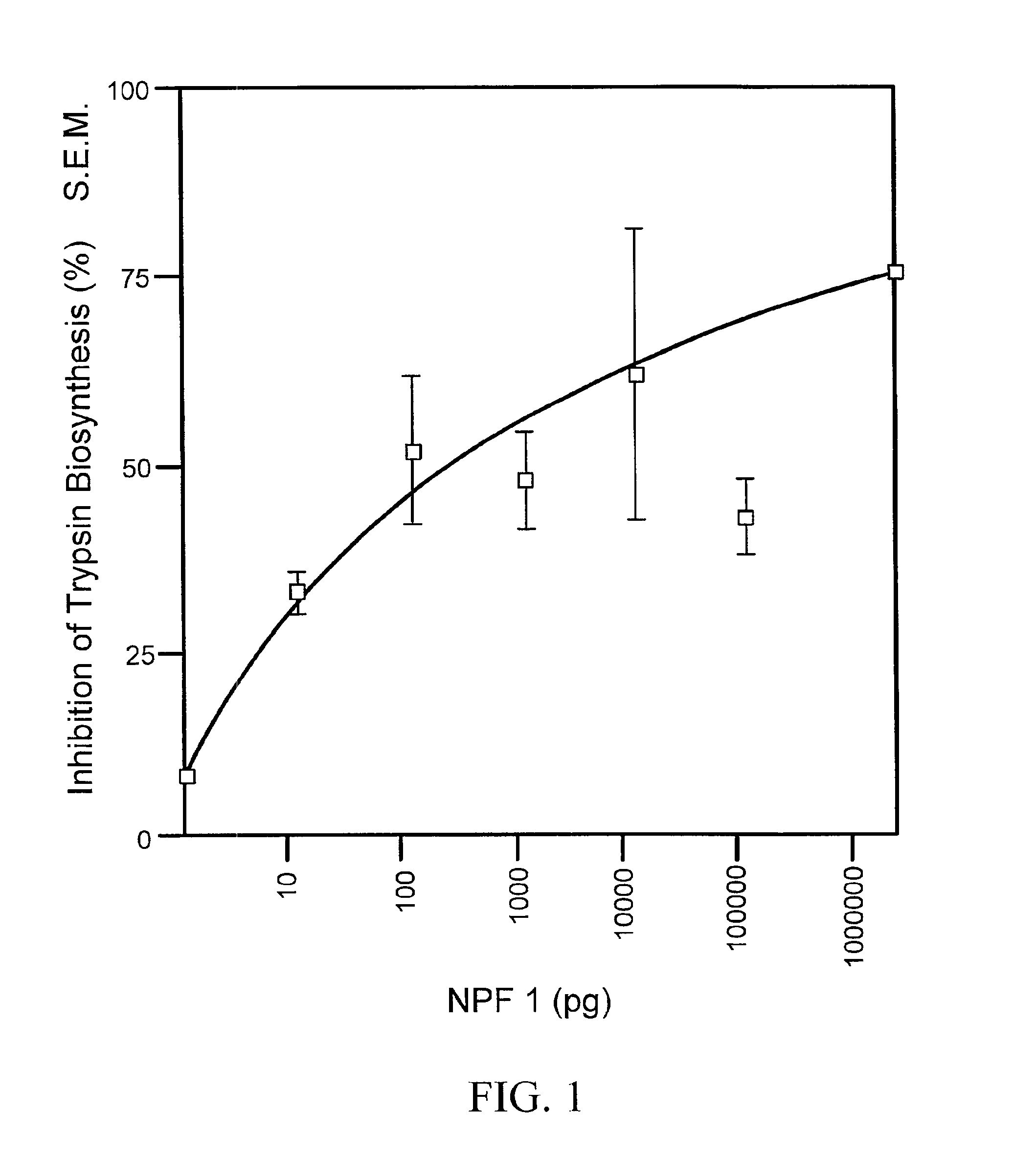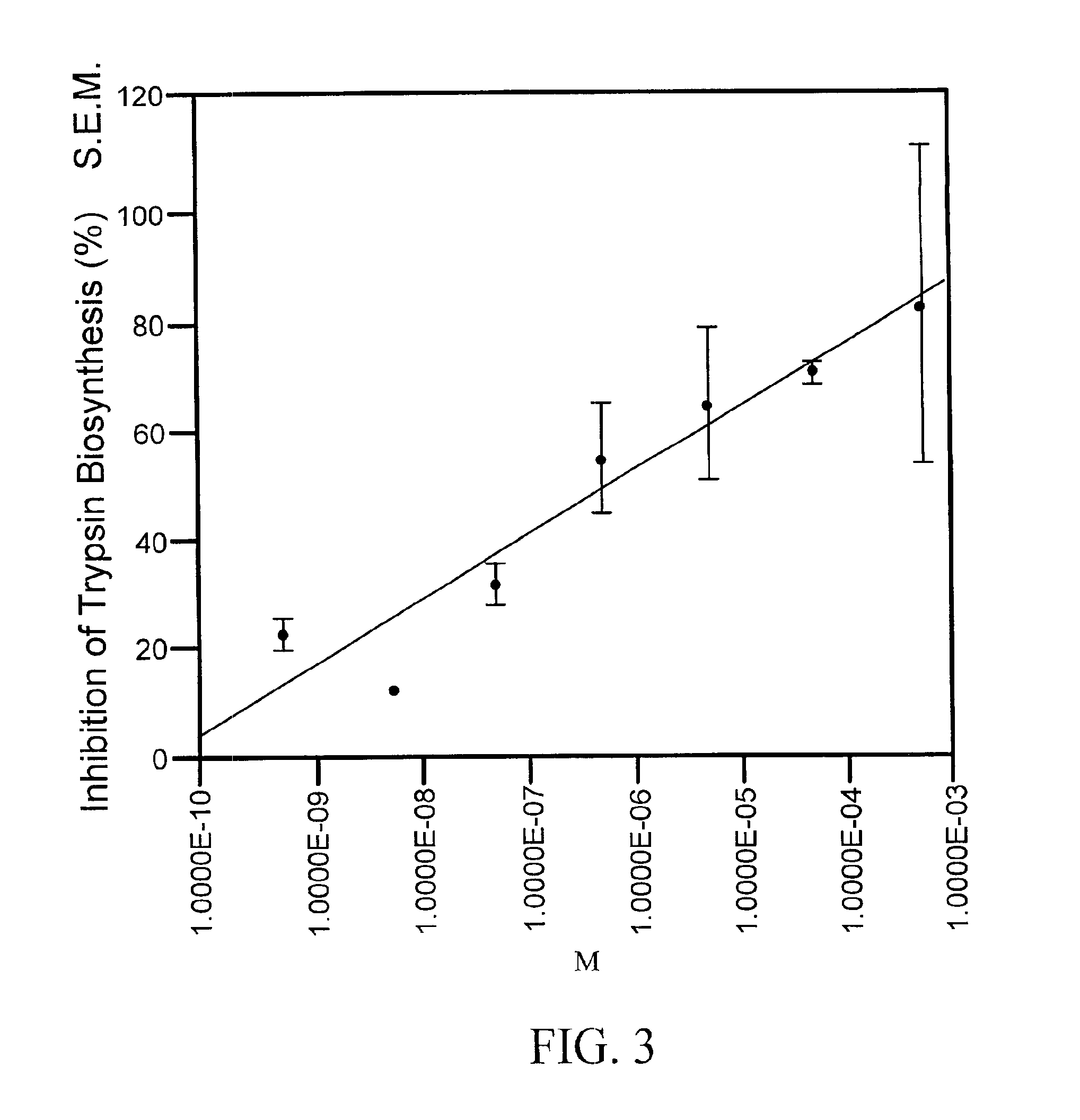Neuropeptides and their use for pest control
a technology of neuropeptides and pests, applied in the direction of peptides, biocides, fused cells, etc., can solve the problems of reducing affecting the survival of animals, so as to reduce the number of pests
- Summary
- Abstract
- Description
- Claims
- Application Information
AI Technical Summary
Benefits of technology
Problems solved by technology
Method used
Image
Examples
example 1
Effect of NPF Polypeptides on Trypsin Biosynthesis
[0091]To find out if NPF I and II affect trypsin biosynthesis in the midgut of female Aedes aegypti, females were fed a blood meal and immediately injected with 0.25 μl of the peptide at concentrations of 2.5 μg to 12.5 pg and 30 hours later the midguts were removed and assayed for trypsin biosynthesis (Borovsky et al., 1990 “Mosquito Oostatic Factor: A Novel Decapeptide Modulating Trypsin-Like Enzyme Biosynthesis in the Midgut” FASEB J. 4:3015-3020; Borovsky et al 1993 “Mass Spectrometry and Characterization of Aedes aegypti Trypsin Modulating Oostatic Factor (TMOF) and its Analog” Insect Biochem. Molec. Biol. 23:703-712). Each experiment was repeated 3 times (5 females per group) and the results are expressed as % inhibition of trypsin biosynthesis±S.E.M. (FIG. 1). Fifty percent inhibition of trypsin biosynthesis was achieved at a concentration of 10−6M NPF I. NPF II was effective at a dose of 10−3M (78%±10), at 10−6M NPF II inhibi...
example 2
Effect of NPF Polypeptides on Mosquito Larvae
[0093]NPF polypeptides of the subject invention have been found to be highly effective pest control agents. NPF polypeptides sharing sequence homology with NPF I and NPF II of the Colorado potato beetle (Leptinotarsa decemlineata) (Spittaels, et al. Insect Biochem. Mol. Biol., 26(4):375-382, 1996) have been identified in the American cockroach (Periplaneta americana) (Veenstra and Lambrou, Biochem. Biophys. Res. Commun., 213(2):519-524, 1995), mosquito (Aedes aegypti) (Stanek et al., Display Presentation, Entomological Society of America Annual Meeting, Montreal, Canada, Dec. 3-6, 2000), and fruit fly (Drosophila melanogaster), and their pesticidal activity was confirmed. Synthesized polypeptides corresponding to the native polypeptides of Colorado potato beetle (SEQ ID NO. 1), mosquito (SEQ ID NOs. 5 and 7), American cockroach (SEQ ID NOs. 9 and 11), and fruit fly (SEQ ID NOs. 13 and 15) were provided to first instar Aedes aegypti larvae...
example 3
Cytoimmunochemical Analysis
[0096]Cytoimmunochemical analysis of the mosquito gut after the blood meal using antiserum against NPF I revealed that exocrine cells with NPF I-like molecules are synthesized by the mosquito epithelial cells 24 hours after a blood meal. In females that did not take a blood meal these cells are not found. Thus, it is possible that NPF I is a secondary signal in a cascade of signals that starts with the release of TMOF from the ovary, the hormone then birids to a TMOF gut receptor (Borovsky et al., 1994) that stimulates the synthesis and release of NPF I from gut specific exocrine cells. NPF I binds to a receptor NPF I binds to a receptor site on the gut the binding site may be adjacent to or part of the TMOF receptor and causes the cessation of trypsin biosynthesis.
PUM
| Property | Measurement | Unit |
|---|---|---|
| depth | aaaaa | aaaaa |
| concentrations | aaaaa | aaaaa |
| surface area | aaaaa | aaaaa |
Abstract
Description
Claims
Application Information
 Login to View More
Login to View More - R&D
- Intellectual Property
- Life Sciences
- Materials
- Tech Scout
- Unparalleled Data Quality
- Higher Quality Content
- 60% Fewer Hallucinations
Browse by: Latest US Patents, China's latest patents, Technical Efficacy Thesaurus, Application Domain, Technology Topic, Popular Technical Reports.
© 2025 PatSnap. All rights reserved.Legal|Privacy policy|Modern Slavery Act Transparency Statement|Sitemap|About US| Contact US: help@patsnap.com



